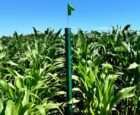Think “multi.”
A new study that looks at the efficacy of pig manure as a nutrient source is multi-state, multi-year and highly multifaceted. A core tenant, says Teng Lim extension professor of agricultural systems technology in the University of Missouri Division of Plant Science and Technology, is understanding that the study looks at more than just yields.
The five-year study (which Lim clarifies is “at least five years”) is taking place in multiple Midwestern pig-producing states. It’s funded by the National Pork Board, with South Dakota State University acting as the lead institution on the study. It looks at corn yields and soil health indicates under three separate treatments – injected pig manure, a combination of manure and starter fertilizer, and chemical fertilizer alone.
The first year of the study concluded with the 2024 harvest season. The inorganic plots (treated solely with chemical fertilizer) had the lowest corn yield (about 150 bushels per acre). However, the differences among treatments were not statistically significant, with the highest yield (from pig manure only) only being around 20 more bushels per acre. Despite this fact, there’s still much to be uncovered.
Manure Manager caught up with Lim to discuss the first year of the study and what’s been learned.
Although early results do not indicate a great difference in the yield, Lim emphasizes that things will only get more interesting from here. “Keep in mind, this is just the first year, and we don’t even have the soil health data yet,” Lim tells Manure Manager.
Soil samples at various depths up to 24 inches were taken by at the start of the study, and additional samples will be taken throughout the study.
“We’re not just looking at typical NPK values that a lot of the growers tend to think of,” says Lim, referring to the key performance indicators the team will look at when it comes to soils. “We’re focusing more across the spectrum of health indicators. Things like the propensity, the holding capacity, the wet aggregate stability. A lot of those additional measurements are important to consider. Like, for example, infiltration. A field that has bad infiltration, you’re not going to be able to keep that much water. It’s just going to be running off the field, so that’s a waste of resources.”
The indicators are so plentiful, says Lim, that this is why the study is ideally at least five years long.
Little is known about the soil health impact yet, but Lim says even when results come, they will surely vary over the years. “Part of the reason we call this at least a five-year study is we expect variability over time,” he says.
The team anticipates that changes in weather, soil conditions and field conditions will affect the variables it’s observing. “Hopefully over the course of five years, we’ll be able to see on this more intensive corn-corn operation, what are the semi-longterm impacts that those different fertilizer treatments have on the yield and soil health indicators.”
The team is keeping an open mind about what variables to expect – from super wet years to super dry years. “We don’t know how it will pan out.”
The fields chosen – as well as the chemical fertilizers used – were chosen to be as reflective as possible of local conditions and operational norms. For example, in the Missouri region where Lim’s team is observing results, there is no irrigation on the plots, because irrigation is not typical for the region.
All states participating are states with large swine production industries. Corn was chosen largely because it is known to need a lot of fertilizer.















